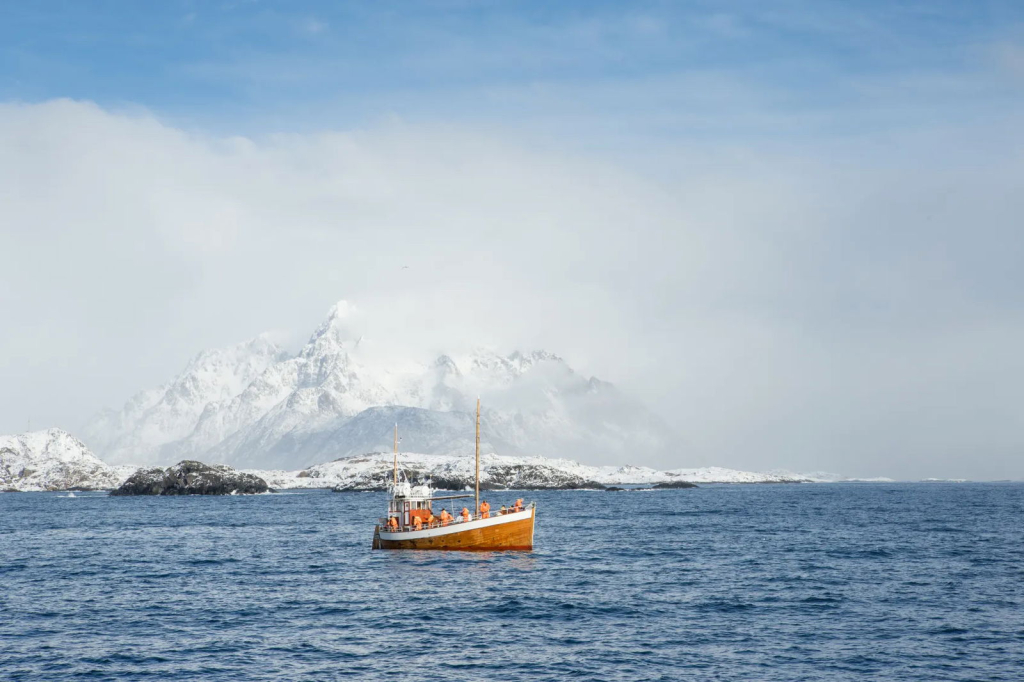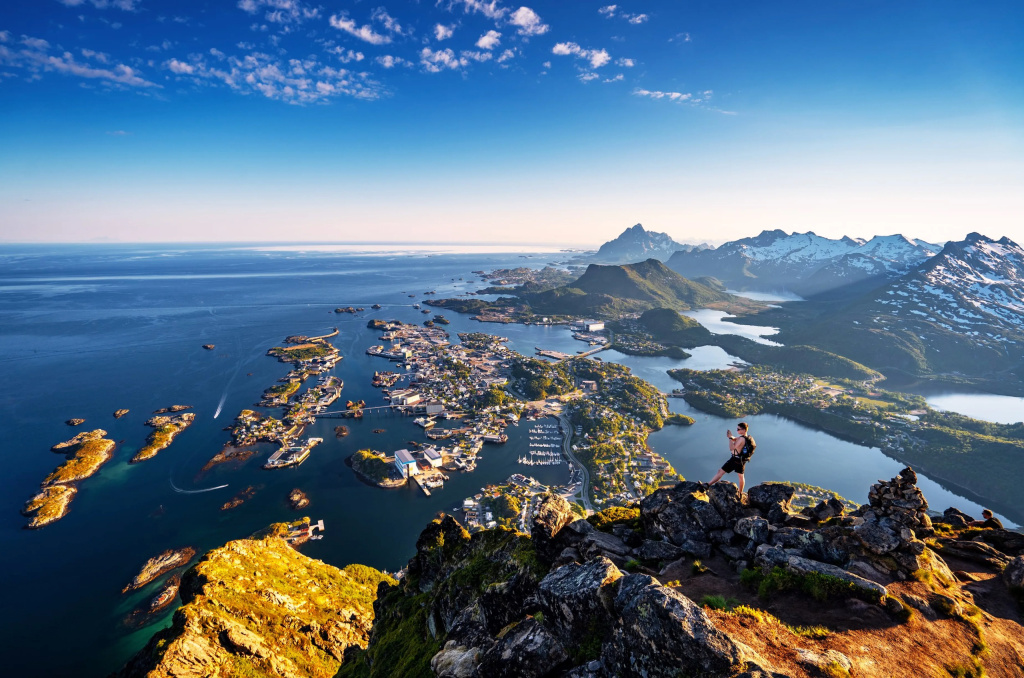
Travel to the Lofoten Islands
The Lofoten Islands, known for their dramatic mountains and picturesque coastline, are a must-visit destination in Northern Norway. This guide will help you navigate the various options for reaching this beautiful archipelago.
Direct Flights to Lofoten Islands
Flying is one of the most efficient ways to travel to the Lofoten Islands, offering stunning aerial views of Norway's rugged terrain and coastal beauty. Several airports and airlines provide convenient access to this remote archipelago.
Main Airports Serving Lofoten
To reach the Lofoten Islands by plane, you can fly into several nearby airports, each offering different advantages:
Bodø Airport (BOO): Located on the mainland, Bodø Airport is a major gateway to Lofoten. From here, you can take a direct flight to one of Lofoten's local airports or opt for a scenic ferry ride to the islands.
Harstad/Narvik Airport (EVE): Situated in Evenes, this airport provides direct connections to Lofoten via bus or car ferry. It's a convenient option for travelers coming from international destinations.
Leknes Airport (LKN): One of Lofoten's local airports, Leknes Airport offers direct flights from Bodø and other regional hubs. It's centrally located, making it a great starting point for exploring the islands.
Svolvær Airport (SVJ): Another local airport in Lofoten, Svolvær Airport has direct flights from Bodø and provides easy access to the eastern part of the archipelago.
Airlines and Flight Options
Several Norwegian airlines operate flights to and within Lofoten:
Widerøe Airlines: This regional airline offers multiple daily flights from Bodø to both Leknes and Svolvær, making it a reliable choice for travelers heading to Lofoten. Widerøe Airlines also provides connections to other Norwegian cities.
Norwegian Airlines and SAS Airlines: Both airlines offer flights to Bodø and Harstad/Narvik from major Norwegian cities, as well as international destinations. From these airports, you can connect to Lofoten via a short Widerøe flight or other transportation options.
Reaching Lofoten by Ferry (and train)
Once in Northern Norway, a popular option to reach Lofoten is by ferry. The car ferry from Bodø to Moskenes is a scenic route that operates regularly, allowing vehicle passengers and foot passengers to travel comfortably.
Additionally, express ferry from Bodø provide a faster alternative for those not traveling with a vehicle. From Oslo, you can travel by train all the way to Bodø, making it a scenic and relaxing journey. The first leg of the trip involves a seven-hour train ride from Oslo to Trondheim. After arriving in Trondheim, you can continue your journey with a ten-hour train ride to Bodø. To make the journey more comfortable, you might consider spending a night in Trondheim to break up the trip. This can be a great opportunity to explore another beautiful Norwegian city.
Hurtigruten and Havila coastal route, both northbound and southbound, stop at several ports in Lofoten. They offer another scenic way to reach the islands.
Summer 2024: The Arctic Route (bus)
During the summer of 2024, you can explore the Lofoten Islands by bus in an easy and flexible way. The Arctic Route offers safe, comfortable, and reliable bus routes, providing full individual freedom for your travels.
Discover Lofoten with the Arctic Route
The convenient hop-on hop-off bus service allows you to discover the breathtaking beauty of Lofoten at your own pace. Travel between the charming village of Svolvær and the picturesque village of Å with ease.
Daily Connections and Onboard Amenities
With daily connections to Evenes Airport and Narvik train station, this bus service is the perfect way to immerse yourself in the stunning landscapes of Lofoten. The buses feature English-speaking drivers, free Wi-Fi, and onboard toilets, ensuring a comfortable journey. This daily service operates between June and August.
Flexible Travel Pass
Additionally, you can use your travel pass on both this route and the Tromsø – Lofoten (Svolvær) – Tromsø route, giving you even more flexibility to explore Northern Norway.
Driving to Lofoten by car
For those who prefer a road trip, driving from Oslo to Lofoten is an option, although a long one, taking about 18-20 hours without stops. Major car rental agencies are available at all major airports, making it easy to rent a car for the journey.
The drive includes toll roads and offers a more scenic route through Southern Norway, up past the Arctic Circle, and into the stunning landscapes of Lofoten. This journey allows you to experience the diverse and beautiful regions of Norway, from lush forests and serene lakes to rugged mountains and dramatic coastlines. It's an adventure that showcases the country's natural beauty at every turn, making the long drive worthwhile.
Where are the Lofoten Islands Located?
The Lofoten Islands are situated in Northern Norway, above the Arctic Circle, offering a dramatic and breathtaking landscape. This archipelago is renowned for its striking natural beauty, featuring towering mountains, deep fjords, picturesque villages, and pristine beaches.
Geographic Location
Lofoten is located within the county of Nordland, stretching from the mainland into the Norwegian Sea. The islands lie about 200 kilometers (124 miles) north of the Arctic Circle, making them one of the best places in the world to experience natural phenomena such as the midnight sun during summer and the northern lights in winter.
Key Islands and Villages
The main islands in the Lofoten archipelago include Austvågøy, Vestvågøy, Flakstadøy, and Moskenesøy. Each island has its own unique charm and attractions. Key villages such as Svolvær, the administrative center, and Reine, often considered one of the most beautiful villages in Norway, offer visitors a glimpse into the traditional Norwegian coastal life.
Accessibility
Despite their remote location, the Lofoten Islands are accessible by various modes of transportation, including flights, ferries, and road trips, making them an increasingly popular destination for travelers seeking unspoiled natural beauty and outdoor adventures.
The combination of dramatic mountains, deep blue waters, and traditional fishing communities make Lofoten a unique and unforgettable destination within Northern Norway.
How Many Days to Spend in Lofoten
To truly experience the Lofoten Islands, plan to spend at least 4-5 days exploring the region. This allows enough time to enjoy the natural beauty, including the northern lights in winter or the midnight sun in summer, as well as partake in activities like hiking, fishing, and kayaking.
Best Time to Visit Lofoten
The best months to visit Lofoten depend on what you want to experience. Summer months (June to August) offer mild weather and endless daylight, ideal for outdoor activities. Winter months (November to February) are perfect for witnessing the northern lights.
Find inspiration for you Lofoten adventure
Top Reasons to Choose a Lofoten RIB Boat for Your Adventure
07. February 2025






